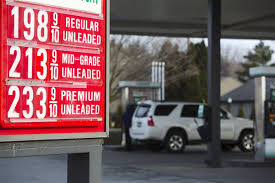
In January, Americans in the aggregate spent some $6.7 billion less at the pump. But retail sales, excluding gas, actually dipped a bit from November to January. The figures suggest that consumers are using the money they save in gasoline purchases to reduce debt or increase savings. That is a carry-over from the Great Recession that made serious inroads into the country’s economy and left the average American a little leery of spending. Although that impedes economic growth in the near-term, it could have positive effects in the future, the experts say.
They are predicting annualized growth of 2.5 percent from January through March, a half point under the 3 percent they had forecast earlier.
Gas prices continue to remain low, although they have risen somewhat. In January, the average per-gallon price of $2.03 per gallon was the lowest since 2009. The price had gone up to $2.24 by late February, but that still is $1.10-per-gallon less than a year ago. The annual savings to a typical household is about $750, according to the Energy Information Administration. To keep a pulse on the changes in prices visit GasBuddy.com.
But with the left-over cautions bred by the recession still echoing, much of that savings will remain pocketed, the administration predicts. Americans are still cautious about overspending. They are saving more instead. The rate of savings rose to 4.9 percent of earnings in December, compared with 4.3 percent in November. Last month, the rate bumped up again, to 5.3 percent, the highest in a year and a half.
Some economists note that the savings from gas purchases are small, although they can grow over time. The cumulative effects don’t show up quickly. Also, many Americans are skeptical that the relatively low gas prices will last. They are cautious about spending the difference when it could be used to help reduce debt. The phenomenon is not new. Economists are aware that consumers tend to “wait and see” before they feel free to spend “found” money they hadn’t figured into their budgets. A lag of several months is typical.
Even so, signs indicate that the money will begin to make an impact on the economy in the coming months. New cars is one of the places it may be spent. Families that put off replacing a vehicle when the economy was sour may feel confident enough to make the splurge. In early 2013, the average age of a car in the U.S. was at a high of nearly 12 years. But last year, more families replaced their clunkers and car sales were at the highest in eight years. And the trend seems set to continue.